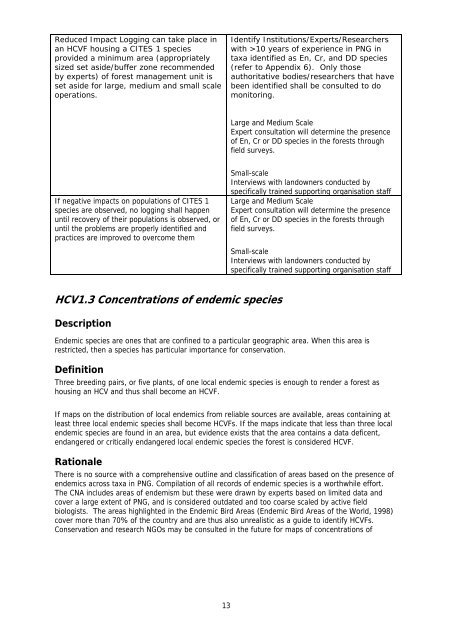A National Interpretation of the High Conservation Value Forest ...
A National Interpretation of the High Conservation Value Forest ...
A National Interpretation of the High Conservation Value Forest ...
You also want an ePaper? Increase the reach of your titles
YUMPU automatically turns print PDFs into web optimized ePapers that Google loves.
Reduced Impact Logging can take place in<br />
an HCVF housing a CITES 1 species<br />
provided a minimum area (appropriately<br />
sized set aside/buffer zone recommended<br />
by experts) <strong>of</strong> forest management unit is<br />
set aside for large, medium and small scale<br />
operations.<br />
Identify Institutions/Experts/Researchers<br />
with >10 years <strong>of</strong> experience in PNG in<br />
taxa identified as En, Cr, and DD species<br />
(refer to Appendix 6). Only those<br />
authoritative bodies/researchers that have<br />
been identified shall be consulted to do<br />
monitoring.<br />
Large and Medium Scale<br />
Expert consultation will determine <strong>the</strong> presence<br />
<strong>of</strong> En, Cr or DD species in <strong>the</strong> forests through<br />
field surveys.<br />
If negative impacts on populations <strong>of</strong> CITES 1<br />
species are observed, no logging shall happen<br />
until recovery <strong>of</strong> <strong>the</strong>ir populations is observed, or<br />
until <strong>the</strong> problems are properly identified and<br />
practices are improved to overcome <strong>the</strong>m<br />
Small-scale<br />
Interviews with landowners conducted by<br />
specifically trained supporting organisation staff<br />
Large and Medium Scale<br />
Expert consultation will determine <strong>the</strong> presence<br />
<strong>of</strong> En, Cr or DD species in <strong>the</strong> forests through<br />
field surveys.<br />
Small-scale<br />
Interviews with landowners conducted by<br />
specifically trained supporting organisation staff<br />
HCV1.3 Concentrations <strong>of</strong> endemic species<br />
Description<br />
Endemic species are ones that are confined to a particular geographic area. When this area is<br />
restricted, <strong>the</strong>n a species has particular importance for conservation.<br />
Definition<br />
Three breeding pairs, or five plants, <strong>of</strong> one local endemic species is enough to render a forest as<br />
housing an HCV and thus shall become an HCVF.<br />
If maps on <strong>the</strong> distribution <strong>of</strong> local endemics from reliable sources are available, areas containing at<br />
least three local endemic species shall become HCVFs. If <strong>the</strong> maps indicate that less than three local<br />
endemic species are found in an area, but evidence exists that <strong>the</strong> area contains a data deficent,<br />
endangered or critically endangered local endemic species <strong>the</strong> forest is considered HCVF.<br />
Rationale<br />
There is no source with a comprehensive outline and classification <strong>of</strong> areas based on <strong>the</strong> presence <strong>of</strong><br />
endemics across taxa in PNG. Compilation <strong>of</strong> all records <strong>of</strong> endemic species is a worthwhile effort.<br />
The CNA includes areas <strong>of</strong> endemism but <strong>the</strong>se were drawn by experts based on limited data and<br />
cover a large extent <strong>of</strong> PNG, and is considered outdated and too coarse scaled by active field<br />
biologists. The areas highlighted in <strong>the</strong> Endemic Bird Areas (Endemic Bird Areas <strong>of</strong> <strong>the</strong> World, 1998)<br />
cover more than 70% <strong>of</strong> <strong>the</strong> country and are thus also unrealistic as a guide to identify HCVFs.<br />
<strong>Conservation</strong> and research NGOs may be consulted in <strong>the</strong> future for maps <strong>of</strong> concentrations <strong>of</strong><br />
13

















